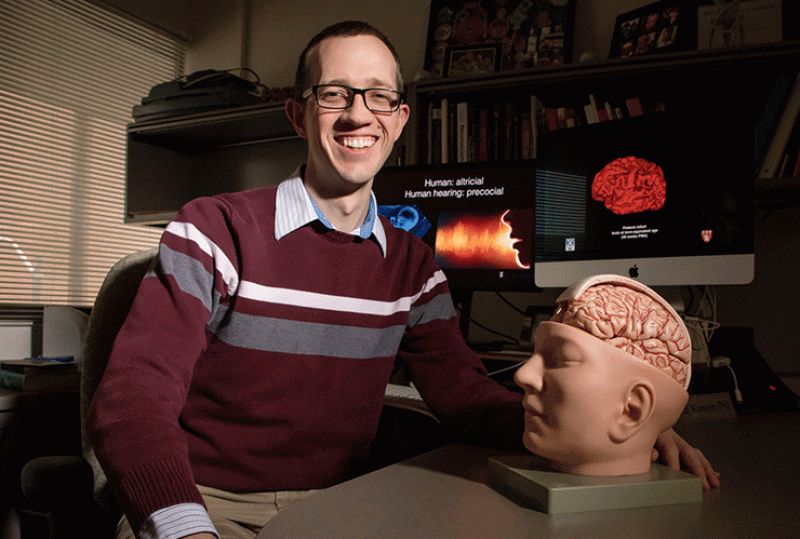
Exploring Extended High-Frequency Hearing
Can you imagine having a conversation that included none of the following consonant sounds: s, sh, f, and ph? Known as voiceless fricatives, much of their energy occurs at the range of human hearing above 8 kilohertz (kHz), called extended high frequencies. In general, consonants tend to have more energy at the extended high frequencies than vowels. Yet conventional clinical hearing tests do not assess the performance of the auditory system above 8 kHz—which is above the highest notes on a piano—because of a longstanding assumption that hearing above 8 kHz is not important.
As Speech and Hearing Science Assistant Professor Brian Monson explains, the assumption took root during the development of the telephone about 100 years ago, when speech signals had to be compressed for transmission across wires. Early researchers simply cut out certain frequencies and asked people if they could still understand what was being said.
“Basically, they found that you didn’t need to hear frequencies above 3 or 4 kHz to have really good intelligibility,” he said, “and that got interpreted as ‘energy at higher frequencies is not important for speech.’”
For more than 10 years, Dr. Monson has been intrigued by and trying to answer the question, “If hearing above 8 kHz is not important, why is the human auditory system capable of hearing up to 20 kHz?” He recently received a five-year, $2 million grant from the National Institute on Deafness and Other Communication Disorders to continue his work in this area with a study titled “The ecological significance of extended high-frequency hearing in humans,” a study on which he will collaborate with researchers at the University of North Carolina and Boys Town National Research Hospital.
Extended high frequencies and noise
In this area of research, Dr. Monson’s basic hypothesis is that not only does extended high-frequency hearing have utility for humans, it plays a role in speech perception. His research group was one of the first to examine the value of extended high frequencies in the speech signal, and the first to demonstrate that extended high frequencies help listeners to determine whether speakers are facing them or turned away from them.
His research has scientific implications, of course, and expanding the state of knowledge in speech and hearing science means a great deal to Dr. Monson. There also is the potential for practical applications of his findings as well, for audiology testing, diagnosis, and intervention.
First of all, only testing below 8 kHz in the clinic does not measure the true function of the auditory system. Extended high-frequency hearing loss is the most common loss in humans because it occurs naturally with aging, with substantial loss occurring even by middle age. So if extended high frequencies are found to play a significant role in speech comprehension, everyone eventually will be affected and everyone will have undiagnosed, or hidden, hearing losses which are not detected by standard audiograms. To date, Dr. Monson and his colleagues have found a modest relationship between extended high frequencies and speech comprehension, but, importantly, it is in noisy environments that extended high frequencies are the most valuable.
“The number one complaint of hearing aid users, for many years, has been that they still have a hard time understanding speech in noisy situations,” Dr. Monson said. “Hearing aids do not represent extended high frequencies.”
Is the impact on speech comprehension large enough to justify taking on the challenge of developing new hearing aid technologies that restore extended high-frequency hearing? That is one of the questions that he hopes to address in the newly funded study. It will expand on a study published in 2019 that simulated a cocktail party but used only two background talkers. The new study will create an even more realistic noisy environment by using multiple talkers in different locations around a listener, as well as realistic reverberations that recreate how sound bounces around different room settings. It also will include a localization experiment to investigate whether extended high frequencies help listeners to determine where the talker of interest is located, with the assumption that this ultimately helps listeners to tune out other talkers.
While he would like his research to result in effective restorative technologies for individuals with extended high frequency hearing loss, Dr. Monson is excited that it already provides compelling evidence for assessing extended high-frequency hearing in the audiology clinic. In a 2020 paper in Hearing Research, he and others argued that implementation of extended high-frequency audiometry into clinical practice is relatively easy. Furthermore, measurements of hearing loss at extended high frequencies do predict speech perception ability in noise, suggesting such measures could be useful in identifying individuals at risk for listening difficulties in noisy situations. As he continues his research in this area, he hopes that continuing to present his findings through journals and conferences that target audiologists will positively impact clinical practice.
